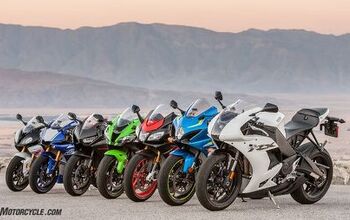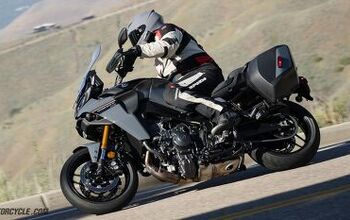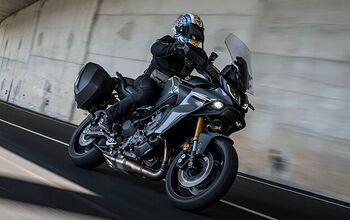Yamaha Racing Motorcycles
You'd be forgiven for thinking that writing a book about Yamaha shouldn't be difficult. The formula seems simple enough.
Colin MacKellar's latest book tracing the history of Yamaha two- stroke road racers is now available in bookstores. Colin has been a regular contributor to Motorcycle Online, providing his own particular brand of GP race reports and interviews with top riders. Here he recounts the pain and pleasure of putting together a 65,000 word treatise on this Japanese company which has been dedicated to racing two-strokes for over 40 years. -Editor
Assemble the Facts.How could that be a problem. I mean the company still exists, so how difficult can it be? A message to Yamaha should do the trick. Something like: AM WRITING BOOK ON YAMAHA TWO-STROKE RACING BIKES STOP SEND ALL YOU HAVE SOONEST STOP WILL SEND COPY OF BOOK WHEN FINISHED STOP THANKS STOP Actually, when I prepared to start writing my first Yamaha book Two-Stroke Twins back in 1983, I naively thought that there would be a wealth of information available from the factory. Pure, 100% certified, indisputably correct facts. Two Yamaha books and 12 years later I've yet to uncover this fountain of knowledge within the company, and I knew before I started on YRB (as the project came to be known ) that I'd get little or no information from them. "I've since decided never to interview someone over lunch as one of you always seems to have his mouth full at the wrong moment."Theoretically, I had access to all the research material I'd collected for Two-Stroke Twins. Only problem was, in a moment of philanthropic zeal, I had donated it to the UK Japanese Vintage Motorcycle Club and had no idea what had happened to it all. A couple of evenings on the telephone resulted in its location and subsequent re-possession of the racing bits. Waves of nostalgia washed over me as I leafed through the TD2 parts book used by Phil Read's mechanic when Read won the 1971 250 World Championship on the air-cooled Yam. Reading the old race bike manuals, I marveled again at the wisdom in their words, words that described a race- winning strategy in Zen-like simplicity.
"The rider must be in good physical condition for racing. Before riding his machine, he should warm up his body by taking light exercise. The rider must bend his body forward and crouch as low as possible behind the cowling so that the air resistance against the body will be greatly reduced. This is one of the best measures to obtain full use of engine power"
With this material available again, at least I felt confident I could do the twins justice.
Factory racers were something else. Accurate substantiated information on the 500 GP bikes was not going to be found in magazines. I turned to the European, American and Australian mechanics and race engineers who had supported the top riders in their battles on the racetracks of Europe. With their assistance I pieced together the complex story of model changes, week on week, year on year. The capacity for detail retention of some of these guys is extraordinary. They can tell you the carb settings on the first practice session of the 1973 Austrian GP like it was last week. Amazing.
Talk to Some Famous Names.
You also need to corner a few individuals to get them to answer some devastatingly revealing questions. Better still, get an endorsement from one of the stars, stating that they've never before encountered such a remarkably readable yet informative book, one which no self-respecting racing enthusiast would risk being without. Best write the endorsement for them; grammar's often not their strongest point.
I've found that interviews with stars only work in the right surroundings and it's sometimes tough to find them. I talked to Kenny Roberts,Wayne Rainey and Giacomo Agostini at the 1993 Dutch TT with three very different results. KR gave me 45 minutes of his time in the sound-proofed luxury of his enormous GP HQ bus with nothing but the hiss of the air-conditioning to disturb us. I managed to break through the static question/answer that characterizes many interviews and he talked freely of his racing during the 70s. A good interview and I felt excited as we stepped out of the bus into the sunshine and KR quipped " Back to reality! " as he disappeared into the pits to help sort out Rainey's 500. I managed to negotiate a 15 minute time slot with the Marlboro Yamaha PR manager to talk to Wayne Rainey, but I remained very conscious of the ticking clock and the TV crew from Hong Kong hovering outside. I couldn't get a real dialogue to flow, but did end up with one or two useful quotes and some answers to my questions.
After a couple of aborted appointments I got hold of Agostini and he invited me to lunch with him and a friend who'd been hanging around the pits all morning. Walking over to the Cagiva hospitality suite she whispered to me in a heavy aside "He's wonderful, you know", and I don't think she was referring to his time riding Yamahas. I've since decided never to interview someone over lunch as one of you always seems to have his mouth full at the wrong moment. We were continuously interrupted by dark suited men who engaged Ago in lengthy conversations in Italian. It soon became clear that Ago would not be able to provide me with any new information on his time riding with Yamaha in the '70s. He seemed surprised when I packed my tape recorder and excused myself after thirty minutes. I think his friend was pleased to see me go.
Put a Slick Marketing Package TogetherOf course you need a sharp cover so that it looks good on the coffee tables the book will spend most of its time lying on. Round the package off with a synopsis full of words like "painstaking, thorough, in-depth, definitive, superbly illustrated", so that buyers understand they've got value for money. Then announce to the world the arrival of the book the motorcycling community has been waiting for with bated breath, sit back and wait for the royalties to roll in.
Nothing to it.
It still took three years from the decision to produce the book until its appearance in the shops. The main problem was that the commissioning publisher went belly up after the '91 recession in the book market. Fortunately, new publishers Crowood were happy to take on the book and within a year the book hit the street.
I've seen a few reviews so far, and they're encouraging. People ask what I'm doing now, expecting me to reveal plans for a new blockbuster title. Actually I'm still enjoying lolling around in front of the TV zapping from re-runs of Cheers to re- runs of Soap to re-runs of .... Can't imagine it'll last much longer though.
Buy it at Amazon.com!Yamaha Racing Motorcycles
(ISBN Number 1 85223 920 4)
192 pages, 160+ pictures (25 color), is priced at $35 from your local bookstore.
More by Colin MacKellar



























Comments
Join the conversation